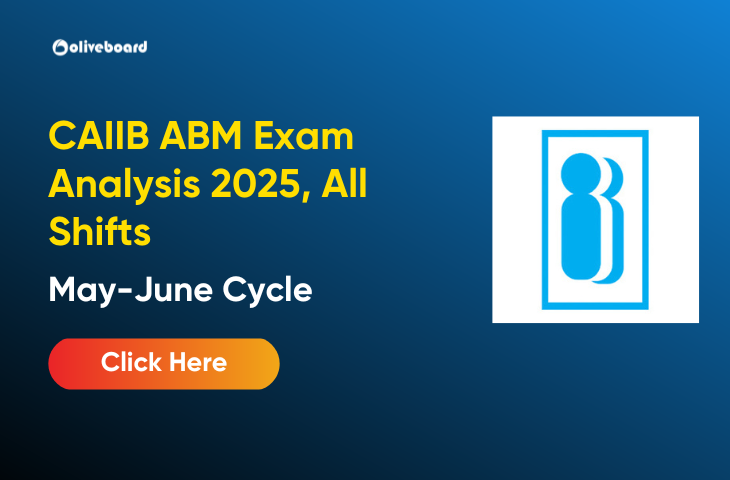Top 50 Most Repetitive CAIIB ABFM MCQs
The Certified Associate of Indian Institute of Bankers (CAIIB) exam is important for banking professionals aiming to advance their careers. Among the various subjects, Advanced Business and Financial Management (ABFM) is one of the most challenging yet rewarding papers. Preparing effectively for this subject requires a clear understanding of its key concepts and practicing the most frequently asked questions. This article provides the top 50 most repetitive CAIIB ABFM MCQs to help you excel in your preparation.
Why Focus on Repetitive Questions?
Repetitive questions give insights into the examiner’s mindset and highlight important topics. Practicing these questions helps:
- Strengthen your understanding of core concepts.
- Save time during revision.
- Boost confidence for the exam.
Important Topics Covered in CAIIB ABFM
Before diving into the MCQs, it is essential to know the primary topics in ABFM:
- Business Strategies and Policies
- Financial Decision Making
- Risk Management
- Leadership and Organizational Dynamics
- Performance Management
- Economic Environment and Banking Trends
Top 50 Most Repetitive CAIIB ABFM MCQs
Here are the most repetitive MCQs:
1. Which of the following is the primary objective of banking regulation in India?
- A) Protecting the interests of borrowers
- B) Ensuring soundness and stability of the banking system
- C) Promoting financial inclusion
- D) Encouraging high interest rates
- Answer: B) Ensuring soundness and stability of the banking system
2. The concept of ‘regulatory forbearance’ refers to:
- A) Allowing banks to operate without any regulation
- B) Temporarily relaxing certain regulatory norms
- C) Strictly enforcing all banking regulations
- D) Granting banks autonomy in setting their own rules
- Answer: B) Temporarily relaxing certain regulatory norms
3. Which of the following is NOT a function of the Reserve Bank of India (RBI)?
- A) Issuing currency notes
- B) Regulating the stock market
- C) Maintaining monetary policy
- D) Supervising financial institutions
- Answer: B) Regulating the stock market
4. The Basel III norms primarily aim at:
- A) Reducing non-performing assets
- B) Strengthening the capital base of banks
- C) Improving the customer service of banks
- D) Increasing the profitability of banks
- Answer: B) Strengthening the capital base of banks
5. What is the primary objective of Asset-Liability Management (ALM) in a bank?
- A) Maximizing profits
- B) Ensuring liquidity and managing interest rate risks
- C) Reducing the cost of funds
- D) Expanding the loan portfolio
- Answer: B) Ensuring liquidity and managing interest rate risks
6. Which of the following is a characteristic of a well-capitalized bank?
- A) Low levels of non-performing assets
- B) High risk exposure
- C) Adequate capital to absorb financial shocks
- D) Limited operational costs
- Answer: C) Adequate capital to absorb financial shocks
7. In banking, what does ‘micro-prudential regulation’ focus on?
- A) The regulation of individual financial institutions
- B) Ensuring the stability of the entire financial system
- C) Long-term financial planning
- D) Preventing market manipulations
- Answer: A) The regulation of individual financial institutions
8. The Capital Adequacy Ratio (CAR) measures:
- A) The total assets of a bank
- B) The ability of a bank to absorb losses
- C) The profitability of a bank
- D) The risk appetite of a bank
- Answer: B) The ability of a bank to absorb losses
9. What is the primary purpose of conducting stress tests in banks?
- A) To measure the profitability of the bank
- B) To assess the bank’s ability to withstand economic shocks
- C) To improve customer satisfaction
- D) To evaluate operational efficiency
- Answer: B) To assess the bank’s ability to withstand economic shocks
10. Which of the following is a feature of a term deposit in banks?
- A) High liquidity
- B) Withdrawals can be made anytime
- C) Fixed interest rate for a specified tenure
- D) Interest is paid monthly
- Answer: C) Fixed interest rate for a specified tenure
11. What is the ‘CAMELS’ rating system used to assess in banks?
- A) The technological infrastructure of a bank
- B) The financial health and soundness of a bank
- C) The customer service quality of a bank
- D) The loan recovery efficiency of a bank
- Answer: B) The financial health and soundness of a bank
12. What does the term ‘NPA’ stand for in banking?
- A) Non-Personal Account
- B) Non-Performing Asset
- C) Non-Paid Asset
- D) Non-Profit Account
- Answer: B) Non-Performing Asset
13. Which of the following is an example of a systematic risk in banking?
- A) A bank’s failure due to bad loans
- B) The overall economic downturn affecting all banks
- C) A bank’s liquidity shortage
- D) A bank’s operational inefficiency
- Answer: B) The overall economic downturn affecting all banks
14. The SLR (Statutory Liquidity Ratio) is the percentage of a bank’s total deposits that it must maintain in the form of:
- A) Cash
- B) Government securities
- C) Loans to customers
- D) Reserves with the RBI
- Answer: B) Government securities
15. In the context of risk management, the ‘Value at Risk’ (VaR) refers to:
- A) The total capital required by a bank
- B) The maximum potential loss in value of an asset over a given time period at a given confidence interval
- C) The operational costs of a bank
- D) The daily fluctuations in interest rates
- Answer: B) The maximum potential loss in value of an asset over a given time period at a given confidence interval
16. Which of the following financial ratios is used to measure the liquidity position of a bank?
- A) Debt-Equity Ratio
- B) Current Ratio
- C) Liquidity Coverage Ratio (LCR)
- D) Return on Assets (ROA)
- Answer: C) Liquidity Coverage Ratio (LCR)
17. Which of the following is a limitation of the ‘return on equity’ (ROE) ratio?
- A) It ignores risk factors
- B) It measures profitability relative to total assets
- C) It does not account for capital structure
- D) It does not measure operational efficiency
- Answer: A) It ignores risk factors
18. Which of the following is a key feature of a ‘structured product’ in banking?
- A) It offers high liquidity
- B) It is a fixed-income security
- C) It is created by combining different financial instruments
- D) It is fully government-backed
- Answer: C) It is created by combining different financial instruments
19. In banking, what is meant by ‘net interest margin’ (NIM)?
- A) The difference between the interest income and interest expenses of a bank
- B) The total interest income generated by a bank
- C) The total expenses incurred by a bank in a given year
- D) The rate at which a bank lends to its customers
- Answer: A) The difference between the interest income and interest expenses of a bank
20. What is the primary objective of the KYC (Know Your Customer) norms in banking?
- A) To increase profitability
- B) To prevent money laundering and fraud
- C) To improve customer service
- D) To enhance market share
- Answer: B) To prevent money laundering and fraud
21. Which of the following best defines ‘counterparty risk’ in a banking transaction?
- A) The risk that a bank may fail to meet its payment obligations
- B) The risk associated with economic downturns
- C) The risk that a party involved in a transaction may default on its obligations
- D) The risk associated with market fluctuations
- Answer: C) The risk that a party involved in a transaction may default on its obligations
22. Which of the following is an example of a ‘systemic risk’ in banking?
- A) Default by a single borrower
- B) Default by a major financial institution
- C) High operational costs
- D) Increased competition in the market
- Answer: B) Default by a major financial institution
23. Which of the following is a component of the ‘CAMELS’ rating system?
- A) Capital adequacy
- B) Market share
- C) Customer satisfaction
- D) Operational costs
- Answer: A) Capital adequacy
24. Which of the following is a characteristic of a ‘shadow bank’?
- A) It is fully regulated by RBI
- B) It does not accept deposits
- C) It primarily offers savings accounts
- D) It is a commercial bank
- Answer: B) It does not accept deposits
25. Which of the following is a potential disadvantage of a high capital adequacy ratio (CAR)?
- A) It increases the bank’s risk exposure
- B) It may reduce the bank’s profitability
- C) It reduces the bank’s asset base
- D) It limits the bank’s liquidity
- Answer: B) It may reduce the bank’s profitability
26. What is the purpose of the ‘base rate’ in banking?
- A) To determine the interest rate on savings accounts
- B) To set the minimum interest rate for loans offered by banks
- C) To regulate the stock market
- D) To monitor the bank’s capital adequacy
- Answer: B) To set the minimum interest rate for loans offered by banks
27. What is the ‘reverse repo rate’ used for by the Reserve Bank of India (RBI)?
- A) To control inflation
- B) To control money supply by borrowing from banks
- C) To manage fiscal deficits
- D) To encourage banks to lend more
- Answer: B) To control money supply by borrowing from banks
28. What is ‘risk-based supervision’ in banking?
- A) Focusing on high-risk activities
- B) A supervisory approach that allocates resources based on risk exposure
- C) Focusing on operational efficiency
- D) Ensuring that banks comply with all regulations
- Answer: B) A supervisory approach that allocates resources based on risk exposure
29. Which of the following is a key factor affecting a bank’s profitability?
- A) Interest rate fluctuations
- B) Customer satisfaction levels
- C) The number of branches
- D) Government regulations
- Answer: A) Interest rate fluctuations
30. Which of the following describes ‘liquidity risk’ in banking?
- A) The risk that a bank’s assets will decline in value
- B) The risk that a bank cannot meet its short-term financial obligations
- C) The risk of losing money on investments
- D) The risk of not attracting enough customers
- Answer: B) The risk that a bank cannot meet its short-term financial obligations
31. Which of the following is a characteristic of a ‘liquidity coverage ratio’ (LCR)?
- A) It is used to determine the profitability of a bank
- B) It measures the short-term liquidity position of a bank
- C) It measures the long-term solvency of a bank
- D) It determines the loan approval process in banks
- Answer: B) It measures the short-term liquidity position of a bank
32. What does the term ‘asset quality review’ (AQR) refer to in banking?
- A) A review of a bank’s asset portfolio for possible risks
- B) A review of a bank’s capital adequacy
- C) A review of a bank’s liquidity position
- D) A review of a bank’s operational efficiency
- Answer: A) A review of a bank’s asset portfolio for possible risks
33. What is the term used for the provision made by a bank to cover potential future loan losses?
- A) Loan recovery
- B) Loan write-off
- C) Loan provision
- D) Loan restructuring
- Answer: C) Loan provision
34. Which of the following is considered a ‘leading indicator’ for a bank’s financial health?
- A) Return on Assets (ROA)
- B) Gross Non-Performing Assets (NPA)
- C) Capital Adequacy Ratio (CAR)
- D) Net Interest Margin (NIM)
- Answer: A) Return on Assets (ROA)
35. What does ‘risk-adjusted return on capital’ (RAROC) help measure?
- A) A bank’s total revenue
- B) A bank’s profitability adjusted for its risk
- C) A bank’s operational efficiency
- D) A bank’s liquidity position
- Answer: B) A bank’s profitability adjusted for its risk
36. Which of the following is a key factor in determining the strength of a bank’s internal controls?
- A) Profit margin
- B) Return on Equity (ROE)
- C) The adequacy of governance and risk management frameworks
- D) The geographical expansion of the bank
- Answer: C) The adequacy of governance and risk management frameworks
37. What is meant by ‘financial inclusion’ in banking?
- A) Providing loans only to high-income individuals
- B) Expanding banking services to unbanked and underserved populations
- C) Limiting banking services to urban areas
- D) Offering only premium banking products
- Answer: B) Expanding banking services to unbanked and underserved populations
38. What is the ‘net stable funding ratio’ (NSFR) designed to ensure?
- A) That banks have sufficient short-term liquidity
- B) That banks have adequate long-term funding relative to their assets
- C) That banks have a high rate of return on equity
- D) That banks have minimal operational risks
- Answer: B) That banks have adequate long-term funding relative to their assets
39. In banking, the term ‘retail banking’ primarily refers to:
- A) Lending to large corporations
- B) Offering financial services to individual consumers
- C) Providing investment banking services
- D) Offering only savings accounts
- Answer: B) Offering financial services to individual consumers
40. Which of the following refers to the ‘liability side’ of a bank’s balance sheet?
- A) Loans provided to customers
- B) Deposits from customers and borrowings
- C) Bank’s investments
- D) Income from assets
- Answer: B) Deposits from customers and borrowings
41. What does ‘provision coverage ratio’ (PCR) indicate in banking?
- A) The ratio of total income to provisions
- B) The proportion of non-performing loans that a bank has adequately provided for
- C) The amount of capital required for future losses
- D) The liquidity position of the bank
- Answer: B) The proportion of non-performing loans that a bank has adequately provided for
42. Which of the following best describes the role of ‘bank capital’?
- A) To determine the profitability of the bank
- B) To absorb losses and support the bank’s growth
- C) To limit the amount of loans a bank can issue
- D) To enhance the liquidity position of the bank
- Answer: B) To absorb losses and support the bank’s growth
43. What is the primary function of the ‘bank’s credit committee’?
- A) To decide on the interest rates for loans
- B) To review and approve large loans and credit exposures
- C) To determine the bank’s annual profit target
- D) To supervise the bank’s day-to-day operations
- Answer: B) To review and approve large loans and credit exposures
44. Which of the following is a key objective of conducting ‘due diligence’ in banking?
- A) To determine a borrower’s creditworthiness
- B) To forecast the bank’s profitability
- C) To improve the customer service experience
- D) To evaluate the bank’s operational efficiency
- Answer: A) To determine a borrower’s creditworthiness
45. What is the term used for the process of restructuring a distressed loan in a bank?
- A) Loan recovery
- B) Loan rescheduling
- C) Loan modification
- D) Loan default
- Answer: C) Loan modification
46. Which of the following is considered a ‘lagging indicator’ for bank performance?
- A) Gross Non-Performing Assets (NPA)
- B) Return on Assets (ROA)
- C) Capital Adequacy Ratio (CAR)
- D) Liquidity Coverage Ratio (LCR)
- Answer: A) Gross Non-Performing Assets (NPA)
47. Which of the following is a primary purpose of the ‘Basel Accords’ in banking?
- A) To promote financial inclusion
- B) To establish international banking regulations and standards
- C) To increase profitability for banks globally
- D) To enhance customer satisfaction
- Answer: B) To establish international banking regulations and standards
48. Which of the following financial instruments is used to reduce interest rate risk?
- A) Equity shares
- B) Derivatives (such as interest rate swaps)
- C) Term deposits
- D) Treasury bills
- Answer: B) Derivatives (such as interest rate swaps)
49. The term ‘core banking solutions’ (CBS) refers to:
- A) A system for issuing credit cards
- B) A technology platform for managing banking operations centrally
- C) A policy for reducing interest rates
- D) A method of customer service enhancement
- Answer: B) A technology platform for managing banking operations centrally
50. What does ‘off-balance-sheet financing’ refer to?
- A) Loans that a bank provides directly to its customers
- B) Financial transactions that do not appear on a bank’s balance sheet
- C) The bank’s fixed deposit accounts
- D) The bank’s equity capital
- Answer: B) Financial transactions that do not appear on a bank’s balance sheet
Also Check,
| Related Article | Link |
| Top 50 Most Repetitive CAIIB ABM MCQs | Click here to Check |
| Top 50 Most Repetitive CAIIB BFM MCQs | Click here to Check |
| Top 50 Most Repetitive CAIIB BRBL MCQs | Click here to Check |
| ABM Exam Important MCQs | Click here to Check |
| CAIIB BRBL Questions | Click here to Check |
CAIIB ABFM Exam Preparation Tips
To make the most of these MCQs, follow these tips:
- Understand Concepts: Go beyond rote memorization. Understand the logic behind answers.
- Practice Regularly: Allocate daily time for solving MCQs.
- Mock Tests: Attempt full-length mock exams to improve time management.
- Revise Strategically: Focus more on weak areas.
- CAIIB Electives Exam Analysis 2025, June All Shifts Review

- CAIIB BRBL Exam Analysis 2025, June All Shifts Review

- CAIIB ABFM Exam 2025 Analysis, Shift 1 & 2 – 22nd June 2025

- CAIIB BFM Exam Analysis 2025, All Shift Analysis Released

- CAIIB ABM Exam Analysis 2025, All Shifts, May-June Cycle

- CAIIB Admit Card 2025, Check Steps to Download Call Letter


Hello there! I’m a dedicated Government Job aspirant turned passionate writer & content marketer. My blogs are a one-stop destination for accurate and comprehensive information on exams like Regulatory Bodies, Banking, SSC, State PSCs, and more. I’m on a mission to provide you with all the details you need, conveniently in one place. When I’m not writing and marketing, you’ll find me happily experimenting in the kitchen, cooking up delightful treats. Join me on this journey of knowledge and flavors!
